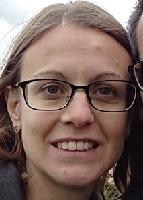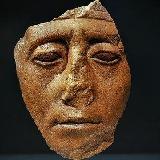Blog
Unless otherwise stated, content is shared under CC-BY-NC Licence
Investing in our Digital Future
Hannah Smith is the Digital Repository Manager at Historic Environment Scotland.
HES Archives Digital Repository is awarded Core Trust Seal accreditation
“A digital future is really the only hope for these things…” was a comment made to me by a colleague regarding the degradation of some colour slides in our collection. These conversations are becoming more and more prevalent in archives, with digitisation and digital preservation becoming one of the biggest risks to archives in recent years. Historic Environment Scotland has been developing its digital archive since the early 1990s and in recent years has had significant investment to develop further.
In October 2021, the HES Archives Digital Repository was awarded CoreTrustSeal certification. Certification is based on requirements established by the World Data Systems (WDS) and the Data Seal of Approval (DSA) reflecting the core characteristics of trustworthy data repositories. HES is the accredited digital repository for heritage data in Scotland, and along with the Archaeology Data Service (ADS), one of only two accredited repositories for heritage data in the UK. CTS certification provides both depositors and funding agencies with the reassurance that data deposited with HES is preserved and remains accessible for future generations.
Unprecedented times
Hania Smerecka is Archivist at Lloyds Banking Group
I sat down to write this during a violent flurry of Whatsapp pings - friends discussing fresh instructions to work from home. I’m not sure how the latest announcements make me feel. Nervous probably, but lucky too, as we got through the last two years safely, adapted, and are in pretty good shape to face whatever is coming.
Our Preservica cloud instance had not yet gone live when Covid first hit the news. We were still finding our way with the application when lockdown entered the banana bread phase. Loo roll shortages were raging while we set up our Calm link and our backlog ingests were running when NHS trusts started appealing for PPE. I was preparing training sessions while *those* Downing Street cheese and wines were or were not taking place.
Digital Preservation and Environmental Sustainability: Five Themes for the Future
[sigue la versión en español]
In November I was invited to speak to the members of RIPDASA in Latin America on the theme of environmental sustainability and digital preservation. This presentation gave me scope to expand a short provocation given on the same theme on the fringes of COP26 which we have also published. It is not exactly a deep dive, but more than a toe in the water. You can also watch the video of the presentation which includes Spanish subtitles.
Thank you very much for the invitation to join you today to share some thoughts about the relationship between digital preservation and environmental sustainability. There’s quite a lot we could say on this issue, so I’d like to cover a lot of ground in the next 15 minutes or so. I have 5 themes.
Firstly, I want to define the digital preservation problem as this will help establish the scope for discussion that follows. Then I want to clarify the relationship between preservation and disposal and look at the opportunities that digital preservation creates to manage and reduce the amount of data we retain. I will then dig a bit more deeply into the ways in which digital preservation consumes energy and the implications that arise from efforts to reduce this consumption. The origin of the energy also matters tremendously as do expectations about access. Towards the end I will take a brief detour into the history of digital preservation as this is not irrelevant to our work. Changes which will disrupt the digital economy will also disrupt our understanding of digital preservation. Finally, I want to reflect on the DPC and how we’re beginning to make changes in our own work.
A Hybrid Model for Web Archive Capture
Claire Newing is Web Archivist at The National Archives in the UK
2021 is the year the UK Government Web Archive came of age. On 4 November we celebrated the 25th birthday of our oldest resource - this archived version of the Environment Agency website. Of course it shared its birthday with World Digital Preservation Day 2021 so a double excuse to celebrate.
Digital Preservation and Climate Change: Provocation to and from COP26
I was privileged to contribute to a panel on the fringes of the COP26 conference in Glasgow this morning convened by the UK National Archives with the title 'Archives Supporting Environmental Sustainability' This short post is the text of my presentation which was the five minute provocation at the start of the session.
Ladies and gentlemen it’s a pleasure to be invited to speak to you this morning. I want to thank the organizers at the National Archives for their efforts in bringing us together for this timely – long overdue discussion.
I have 5 minutes so will attempt 5 themes in 5 minutes ...
Leaning on community resources to build audiovisual transfer capacity at the Borthwick
Mark Simon Haydn is the Digital Preservation Archivist at the Borthwick Institute for Archives at the University of York
In keeping with other reports from the field on the DPC blog, the last twelve months at the Borthwick have deeply involved increased supply and demand of digital collection material. In addition to daily reprographics work performed by the Institute’s searchroom team, there has been great progress with the delivery of grant projects: from significant Music Preserved digitisation supporting the British Library’s Unlocking Our Sound Heritage scheme, performed by Nick Melia, to Chris Taylor’s extensive photography of ephemera recording the activities of regional music societies in the InterMusE project, collections have continued to reach users and inform research in spite of all the obvious obstacles to access, a temporary change in behaviour that suggests a new normal of remote access. Since stepping in as the temporary Digital Preservation Archivist in June, I’ve had chance to spend some time building up the capacity to appraise and transfer some of the Borthwick’s magnetic media holdings, audio and video recordings physically cared for by the Institute’s conservation staff but long inaccessible to researchers in the absence of adequate playback equipment.
Embedding sustainability into systems and tools: a brief case study
Keith Pendergrass is Digital Archivist at Baker Library Special Collections, Harvard Business School.
This is a companion post to the Environmentally sustainable digital preservation - moving from theory to practice webinar.
Since the 2019 article and workshop protocol on environmentally sustainable digital preservation that I wrote with Walker Sampson, Tessa Walsh, and Laura Alagna, I have been using our framework to improve the sustainability of Baker Library’s digital archives program. I have written previously about our efforts to integrate sustainability into policies and workflows. For this post, I am going to look at a recent software development project as an example of how we can embed sustainability into our design and use of digital preservation systems and tools.
Evolving File Format Identification, Migration, and Management for Preservation through Tool Development
Tom J. Smyth (Manager, Digital Preservation) and Maxime Champagne (Digital Preservation Repository Supervisor), Library and Archives Canada
Early this year, it became a priority for LAC’s Digital Preservation unit to reconsider the context of (and affect a major update to) our policy statement on the file formats we accept for transfer of digital library and archival documentary heritage.
In the course of examining the existing documents, a few issues arose for discussion among the preservation divisional staff:
Breaking down barriers in e-only thesis submission: how digital preservation contributes to the conversation at the University of Glasgow
Leo Konstantelos is Senior Assistant Archivist (Digital) in Archives & Special Collections at the University of Glasgow
The Digital Preservation Working Group (DPWG) at the University of Glasgow is a cross-University collaboration working to implement the University’s digital policy and strategy. Established in 2015, the group oversees the delivery of digital preservation services, with representation from the University Library, IT Services and the Data Protection & Freedom of Information Office.
We’ve been busy DP bees recently, assessing Archivematica as a production-level DP platform; reviewing and elaborating on our digital archiving workflow; testing said workflow with born-digital acquisitions at the University Archives; and working on setting up an archival forensics lab. Check our #WDPD2021 posts on Twitter @UofGlasgowASC to see what we’ve been up to!
On Being a Good Ancestor
I had the happy task of opening World Digital Preservation Day about 40 hours ago: but I get the fuzzy end of the lollipop too. Today I have to encourage you back to work. Those Excel spreadsheets aren’t going to screw up the date columns on their own. Oh hang on…
The original idea for World Digital Preservation Day was very simple: to help our far-flung community connect, and to raise awareness about our work. In 2021 we added a theme – we didn’t have themes in the early years – about Breaking Down Barriers to Digital Preservation. Linguists will spot a verb in there, and it’s in the active voice too. So, at least thematically, 2021 has been the most ambitious World Digital Preservation Day yet, with action at its core. There’s a renewed urgency and confidence represented by this theme, growing partly from the many connections and case studies (not to mention cakes and crafts) which have come before.
Urgency and confidence are needed. This last year might be remembered as the year of the great deletion; as the year of obfuscation, misinformation and denial. As technology has become more and more critical to our lives so it has become the means and theatre of division, exploitation and harm. The fragility of digital media has given cover to those who would hide their actions, and misdirection to the gullible who think data loss is inevitable, perhaps even reasonable.
As Richard Ovenden has argued, it’s time to Undelete the Government. My only qualification: not just the UK and not just the government. If I can mix my metaphors, we started World Digital Preservation Day with the idea of breaking down barriers, but perhaps we need to end it by taking to the barricades.
Data loss may seem like a small issue considering the many challenges ahead but rest unassured: corruption, maladministration, disaffection, and incompetence are the inevitable consequences of an entirely avoidable digital dark age.




















































































































































